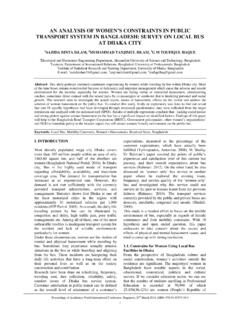Transcription of SWOT ANALYSIS OF CLOUD COMPUTING
1 Proceedings of Fourteenth TheIIER International Conference, Paris, France, 8th March 2015, ISBN: 978-93-82702-72-6 71 swot ANALYSIS OF CLOUD COMPUTING OSMAN OCAK Turkish Air War College Student E-mail: Abstract- In this study, CLOUD COMPUTING is assessed by swot ANALYSIS . Information systems occupy everyday life day by day. It is not a distant idea to think that Future Wars will be directed against information systems. In future, center of war will be a code line in the software. In parallel to the occupation of information systems in our daily life, strength sides of CLOUD COMPUTING provide fast and reliable data process in an economical way with bringing a new understanding to information systems.
2 In spite of the known strengths, weaknesses that CLOUD COMPUTING brings are questionable. Also CLOUD COMPUTING has opportunities and threats. In this study, CLOUD COMPUTING is researched by swot ANALYSIS . Keywords- CLOUD COMPUTING , Information Systems, swot ANALYSIS . I. INTRODUCTION Nowadays, information systems exist in every area of our daily life. One can take accounting services without going to the banks. One can buy tickets whereas sitting at home. Especially after the mobile systems becoming widespread, this change got faster and faster.
3 Parallel to this change, information systems create new areas every day. CLOUD COMPUTING is one of these new areas. According to a study made by International Data Corporation (IDC) which is mentioned in Fig. I, investment in CLOUD COMPUTING in 2017 is going to be over $ 170 billion dollars whereas investments were $ billion in 2013 [4]. According to the same study, between 2013 and 2017, annual increase average of CLOUD COMPUTING will be % [4]. Data provided by IDC, which globally makes research and development, show us that CLOUD COMPUTING is going to provide a wider area in future conflicts.
4 Fig. I Research about CLOUD COMPUTING by IDC [4] By this study, it is aimed to find out Strengths, Weaknesses, Opportunities and Threats ( swot ) of CLOUD COMPUTING . Using literature review method, 2nd section covers general information about CLOUD COMPUTING , 3rd section covers essential characteristics of CLOUD COMPUTING , 4th section covers assessments of swot ANALYSIS and results and discussion is given at 5th section. II. CLOUD COMPUTING A. Definition There are lots of definitions about CLOUD COMPUTING [5].
5 Therefore one single standard definition still has not occurred. Each organization or people according to their respective area make their own definition. One of CLOUD COMPUTING definitions is huge amount of data managed by shared large data centers [2]. We need CLOUD COMPUTING to solve problems caused by managing mass data. Also data continue to increase day by day in shared wide area network of Internet. Managing this data safely and efficiently emerges as a problem area. CLOUD COMPUTING is evaluated to find solutions to these problem areas.
6 Another definition for CLOUD COMPUTING is made by National Institute of Standards and Technology (NIST). NIST described the CLOUD COMPUTING as ..a model for enabling ubiquitous, convenient, on-demand network access to a shared pool of configurable COMPUTING resources ( , networks, servers, storage, applications, and services) that can be rapidly provisioned and released with minimal management effort or service provider interaction. [7]. In the literature the most comprehensive and accepted definition is made by the NIST.
7 B. Service Models Service providers offer three different ways of providing CLOUD COMPUTING [7]. How these service models work is depicted in Fig. II. 1) Software as a Service (SaaS): CLOUD COMPUTING consists of not only software applications distributed over the Internet but also software used on data centers [6]. This is called Software as a Service. swot ANALYSIS of CLOUD COMPUTING Proceedings of Fourteenth TheIIER International Conference, Paris, France, 8th March 2015, ISBN: 978-93-82702-72-6 72 Google Docs and Microsoft 365 are the examples of office applications used online.
8 Fig. II Service Models 2) Platform as a Service (PaaS): In this model, service recipient who take applications by a platform that service providers are serving [7]. It is known as PaaS as an abbreviation. Microsoft Azure application is the example of this model. 3) Infrastructure as a Service (IaaS): It is a service which recipients have no control over data only service providers offer information technology sources [7]. It is known as IaaS as an abbreviation.
9 Internet web-based "Dropbox" is an example of this service model. C. Deployment Models Deployment models differ depending on the purpose of CLOUD COMPUTING usage. Users or service providers can implement the model according to their own needs, privacy and communication policy. It is divided deployment models to four groups [7] that are depicted in Fig. III: Fig. III Deployment Models 1) Public CLOUD : In this model, everyone without any restriction can access to public CLOUD [7].
10 2) Community CLOUD : Users have the same properties as security needs, policy etc. use the architecture of community CLOUD [7]. 3) Hybrid CLOUD : Private or public CLOUD created hybrid CLOUD [7]. Purpose of this CLOUD is to communicate with other CLOUD by protecting its own architecture. 4) Private CLOUD : It is defined private CLOUD as a service whose recipients build their architecture [7]. Information security is better than the other CLOUD deployment models.







